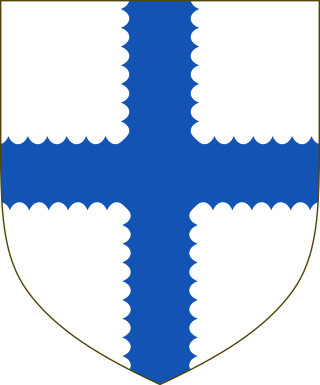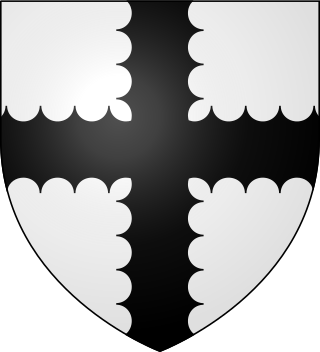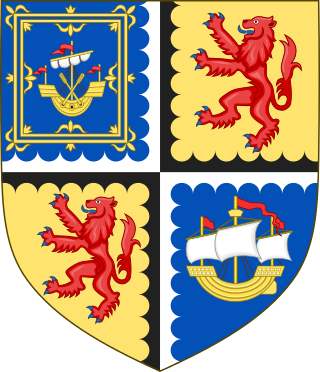

Lord Herdmanston was a title in the Peerage of Scotland that was held by the Sinclair or St Clair family.


Lord Herdmanston was a title in the Peerage of Scotland that was held by the Sinclair or St Clair family.
Herdmanston in East Lothian had been held from the 12th century, when Henry St Clair received a grant of the lands of Herdmanston, from Richard de Morville, Constable of Scotland. [3] It is not known if the Sinclair Lords Herdmanston share a common origin with the Sinclair Barons of Roslin, [4] from whom branch off the Lords Sinclair and Earls of Caithness. [5] According to the website sinclairgenealogy.info, the fact that the first proven Baron of Roslin, William St. Clair (died 1297) was made sheriff of Haddington in East Lothian where Herdmanston also is, suggests that he was appointed there to cover his own home area, and given that the name William appears frequently in the St Clair of Herdmanston family suggests that he may have been part of their extended family. [6] However, according to the website clansinclairusa.org, William St Clair of Roslin was probably unrelated to the St Clairs of Herdmanston. [7] According to Archibald Allan writing in 1900, Henry St Clair of Herdmanston appears to have been a son of the first William de St Clair of Roslin of the 11th century, [5] but this William's existence cannot be proved by contemporary evidence and according to Roland Saint-Clair, William St. Clair who died in 1297 was the first proven Baron of Roslin. [8]
The Sinclairs of Herdmanston are recorded by James Balfour Paul in his The Scots Peerage . [9] They are also recorded by Bernard Burke in his a Genealogical and Heraldic Dictionary of the Peerage and Baronetage of the British Empire, [10] and by 18th century herald, Alexander Nisbet, in his A System of Heraldry. [11] The coat of arms of the Sinclair of Herdmanston family is similar to that of the Lord Sinclair, but the tincture of the cross was changed from azure to sable. [2]
Roland Saint-Clair writing in the late 19th century lists the following Lords Herdmanston: [4]

Lord Sinclair is a title in the Peerage of Scotland. According to James Balfour Paul's The Scots Peerage, volume VII published in 1910, the first person to be styled Lord Sinclair was William Sinclair, 3rd Earl of Orkney and 1st Earl of Caithness. However, according to Roland Saint-Clair writing in the late 19th century, William Sinclair's father, Henry II Sinclair, Earl of Orkney, who died in 1420, is the first person recorded as Lord Sinclair by public records.

Clan Sinclair is a Highland Scottish clan which holds the lands of Caithness, the Orkney Islands, and the Lothians. The chiefs of the clan were the Barons of Roslin and later the Earls of Orkney and Earls of Caithness.
Henry II Sinclair, Earl of Orkney was the Jarl (Earl) of Orkney, Baron of Roslin and Pantler of Scotland. According to Roland Saint-Clair writing in the late 19th century, Henry Sinclair was also the first of his family to hold the title of Lord Sinclair.

Baron of Roslin or Rosslyn was a Scottish feudal barony held by the St Clair or Sinclair family.
James Sinclair, 12th Earl of Caithness (1766–1823) was a Scottish noble, Earl of Caithness and chief of the Clan Sinclair, a Highland Scottish clan.

Sir Henry St Clair was a 13th- and 14th-century Scottish noble, who was the 7th Baron of Roslin and Lord of Catcune.
John Sinclair, Master of Caithness was a Scottish nobleman.

George Sinclair was a Scottish nobleman, 6th Earl of Caithness, and chief of the Clan Sinclair, a Scottish clan of the Scottish Highlands.

William St. Clair, 6th Baron of Roslin was a Scottish nobleman of the late 13th century.

William Sinclair of Newburgh, Aberdeenshire was a Scottish nobleman and the 3rd Lord Sinclair. In The Scots Peerage by James Balfour Paul he is designated as the 2nd Lord Sinclair, but historian Roland Saint-Clair designates him the 3rd Lord Sinclair in reference to his descent from his grandfather, Henry II Sinclair, Earl of Orkney, the first Lord Sinclair. Roland Saint-Clair references this to an Act of the Scottish Parliament in which William Sinclair's son, Henry Sinclair, 4th Lord Sinclair, was made Lord Sinclair based on his descent from his great-grandfather, Henry II Sinclair, Earl of Orkney, the first Lord Sinclair. Bernard Burke, in his a Genealogical and Heraldic Dictionary of the Peerage and Baronetage of the British Empire, agrees with Roland Saint-Clair and says that Henry Sinclair was "in reality" the fourth holder of the title of Lord Sinclair.

William St Clair was a Scottish noble and by tradition the 8th Baron of Roslin.

William St Clair was a Scottish nobleman and the 14th Baron of Roslin.

William Sinclair was a Scottish nobleman and the 5th Lord Sinclair. In The Scots Peerage by James Balfour Paul he is designated as the 4th Lord Sinclair in descent starting from William Sinclair, 1st Earl of Caithness and 3rd Earl of Orkney, but historian Roland Saint-Clair designates him as the 5th Lord Sinclair in descent from the father of the 1st Earl of Caithness and 3rd Earl of Orkney, Henry II Sinclair, Earl of Orkney, who is the first person recorded as Lord Sinclair in public records. Roland Saint-Clair references this to an Act of the Scottish Parliament in which the 4th Lord Sinclair was made Lord Sinclair based on his descent from his great-grandfather, Henry II Sinclair, Earl of Orkney, the first Lord Sinclair. Bernard Burke, in his a Genealogical and Heraldic Dictionary of the Peerage and Baronetage of the British Empire, agrees with Roland Saint-Clair and says that William Sinclair was "in reality" the fifth Lord Sinclair.
Henry St Clair, Lord Herdmanston and Carfrae, was a Scottish noble of the 12th century.

William St Clair was a Scottish nobleman and the 15th Baron of Roslin.

Henry Sinclair was a Scottish nobleman and 7th Lord Sinclair. In The Scots Peerage by James Balfour Paul he is designated as the 6th Lord Sinclair in descent starting from William Sinclair, 1st Earl of Caithness and 3rd Earl of Orkney, but historian Roland Saint-Clair designates him as the 7th Lord Sinclair in descent from the father of the 1st Earl of Caithness and 3rd Earl of Orkney, Henry II Sinclair, Earl of Orkney, who is the first person recorded as Lord Sinclair in public records. Roland Saint-Clair references this to an Act of the Scottish Parliament in which the 4th Lord Sinclair was made Lord Sinclair based on his descent from his great-grandfather, Henry II Sinclair, Earl of Orkney, the first Lord Sinclair. Bernard Burke, in his a Genealogical and Heraldic Dictionary of the Peerage and Baronetage of the British Empire, agrees with the numbering by Roland Saint-Clair and says that Henry Sinclair and William Sinclair were "in reality" the fourth and fifth Lords Sinclair respectively.

James Sinclair was a Scottish nobleman and the 8th Lord Sinclair. In The Scots Peerage by James Balfour Paul he is designated as the 7th Lord Sinclair in descent starting from William Sinclair, 1st Earl of Caithness and 3rd Earl of Orkney, but historian Roland Saint-Clair designates him as the 8th Lord Sinclair in descent from the father of the 1st Earl of Caithness and 3rd Earl of Orkney, Henry II Sinclair, Earl of Orkney, who is the first person recorded as Lord Sinclair in public records. Roland Saint-Clair references this to an Act of the Scottish Parliament in which the 4th Lord Sinclair was made Lord Sinclair based on his descent from his great-grandfather, Henry II Sinclair, Earl of Orkney, the first Lord Sinclair. Bernard Burke, in his a Genealogical and Heraldic Dictionary of the Peerage and Baronetage of the British Empire, agrees with the numbering by Roland Saint-Clair and says that Henry Sinclair and William Sinclair were "in reality" the fourth and fifth Lords Sinclair respectively.

Patrick Sinclair was a Scottish nobleman and the 9th Lord Sinclair. In The Scots Peerage by James Balfour Paul he is designated as the 8th Lord Sinclair in descent starting from William Sinclair, 1st Earl of Caithness and 3rd Earl of Orkney, but historian Roland Saint-Clair designates him as the 9th Lord Sinclair in descent from the father of the 1st Earl of Caithness and 3rd Earl of Orkney, Henry II Sinclair, Earl of Orkney, who is the first person recorded as Lord Sinclair in public records. Roland Saint-Clair references this to an Act of the Scottish Parliament in which the 4th Lord Sinclair was made Lord Sinclair based on his descent from his great-grandfather, Henry II Sinclair, Earl of Orkney, the first Lord Sinclair. Bernard Burke, in his a Genealogical and Heraldic Dictionary of the Peerage and Baronetage of the British Empire, agrees with the numbering by Roland Saint-Clair and says that Henry Sinclair and William Sinclair were "in reality" the fourth and fifth Lords Sinclair respectively.

Alexander St Clair (1672–1706) was the 19th Baron of Roslin.

John Sinclair was a Scottish nobleman and the 10th Lord Sinclair. In The Scots Peerage by James Balfour Paul he is designated as the 9th Lord Sinclair in descent starting from William Sinclair, 1st Earl of Caithness and 3rd Earl of Orkney, but historian Roland Saint-Clair designates him as the 10th Lord Sinclair in descent from the father of the 1st Earl of Caithness and 3rd Earl of Orkney, Henry II Sinclair, Earl of Orkney, who is the first person recorded as Lord Sinclair in public records. Roland Saint-Clair references this to an Act of the Scottish Parliament in which the 4th Lord Sinclair was made Lord Sinclair based on his descent from his great-grandfather, Henry II Sinclair, Earl of Orkney, the first Lord Sinclair. Bernard Burke, in his a Genealogical and Heraldic Dictionary of the Peerage and Baronetage of the British Empire, agrees with the numbering by Roland Saint-Clair and says that Henry Sinclair and William Sinclair were "in reality" the fourth and fifth Lords Sinclair respectively.
{{cite book}}: CS1 maint: location (link){{cite book}}: CS1 maint: location (link)